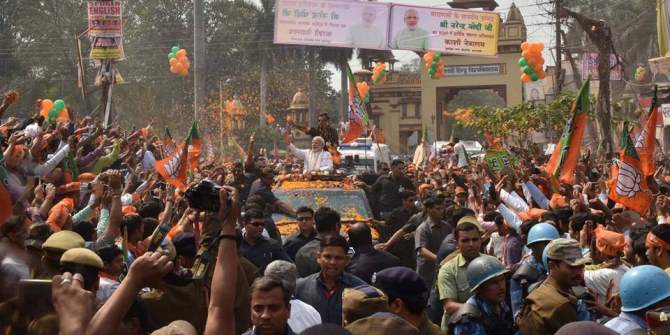In the wake of the recent conclusion of India’s general elections, Abhimanyu Chandra (The University of Chicago) argues that the term “dance of democracy”, commonly used for India’s election seasons, is now an out-dated and overly romantic term. Election seasons in India today instead are escape-from-reality, public relations-driven periods of mania. This transformation in the nature of India’s election seasons is a cause for concern, and may be of disservice to the voter.
An election season in India is regularly characterised as a “dance of democracy”. The recent general election in the country, however, more so than perhaps any other before, calls for a re-evaluation of what India’s election seasons are becoming. “Dance of democracy” is now an out-dated, romanticised, bucolic description. India’s election seasons today are more like escape-from-reality, public relations-driven blitzkriegs. As the country proceeds it must ask itself if this transformation in the nature of its election seasons is cause for concern – and, ultimately, how well or not it is serving the voter.
Reality under siege
The experience of the recent elections and of the weeks preceding it was disorienting. On 26 February, India carried out airstrikes in Pakistan, with the Bharatiya Janata Party (BJP) President Amit Shah and the BJP-leaning media subsequently claiming that more than 250 terrorists had been killed. No evidence of such killings to date has been found – and analysts have said that the strikes fell on trees and empty ground. Yet, large sections of the media got caught up in a nationalist frenzy over the apparent murder of hundreds of Pakistani militants.
The election season was befuddling in further ways, too. During the polling many states witnessed violence, in particular West Bengal. The unreal, surreal quality of the election experience reached perhaps its most urgent when, as the results neared, a flurry of stories broke out on possible problems with the Electronic Voting Machines (EVM) that had been used for voting – regarding their security, possible tampering, and more.
The confounding quality of the election season came further from the “staged” aspect of many of its facets. A Shakespeare character has said that “All the world’s a stage” – PR professionals will tell us that much of an election season is a stage, or staged, from a political rally, to TV “debates”, to decision making on what news gets covered and what does not, to more. Living in Delhi certainly felt less like living in a city, and more like living inside an ad campaign, with publicity materials encircling oneself at bus stands, petrol pumps, traffic stops.
The voter: short-changed
If these various surreal aspects to the election season were not troubling for their own sake, they are particularly troubling given that the voter has little ability to respond to them, and is hoodwinked by false pretences of transparency and spontaneity.
On what basis did the BJP President make his claim of 250 Pakistani terrorists having been killed? Where was the evidence? And if there was none, would he be held accountable for having misled the public? Would media houses that gleefully went along with the story apologise? What could have been done and what, going forward, can be done to stem violence during campaigning and polling? How many lives were lost and how many were injured? Who was culpable? With the concerns over the EVMs, many voters were left asking whether all votes had been counted accurately. Many of these questions remained and still remain on the table, some of them at best partially answered, even as new questions kept piling up. How was the voter to respond to all of this, to seek answers, to demand accountability? Meanwhile, the election results came out.
In India’s political life in general but during election seasons in particular there seems to be no loop between a breaking political news, time for a citizen to digest the news and respond to it should the need arise by, say, taking recourse to legal bodies such as the Election Commission, and for politicians and political parties to then adjust their statements and actions in response to citizens’ responses. Such a loop does not, or barely exists, and now it’s just Breaking News! Breaking News! Breaking News! Breaking News! Election Results Declared! As a result, there is a certain unilateral monologue, rather than a bilateral conversation between politician and citizen. The citizen is left as a helpless, panting, overwhelmed listener, rather than as an interlocutor.
The citizen was further shortchanged because even as he is told that he is king, and that he gets to choose who wins, he really becomes a pawn in a larger, planned, theatre production. The election season is presented by political parties and media houses as one of transparency and spontaneity. No one, of course, sees the PR and ad teams at the back end. An estimated Rs. 5,000 crore was spent this election on advertising. A lot of the funding sources of political parties remain opaque, with provisions allowing businesses to make anonymous contributions. According to N. Bhaskara Rao, chairman of the New Delhi-based Centre for Media Studies, “What is this if not the auctioning of our democracy to the highest-paying corporation?” A seeming nexus among businesses, political parties, the media, the PR industry, and the ad industry, involving breath-taking amounts of money, is at work behind supposedly “transparent” rallies, “fair and spontaneous” TV debates and coverage, and “neutral” public spaces. Little to none of this is properly disclosed to the voter.
With the pace of the news; the piling up of serious concerns regarding political accountability and electoral process; a virtual cloudburst of fake news, breathlessly spread over social media; political spin, gyrations, and promotions enabled by crores spent on public relations efforts – in a word, with the lack of agency felt by the citizen she wanted, through the election season, to shout “STOP!!!” Or more specifically “PAUSE!!!” Amidst the speed of it all the quality of discourse and civic life had withered. The citizen felt shortchanged and disempowered – irrespective of whom she or he may have wanted to vote for.
Disempowerment of the voter
In such a scenario it must be asked: Is the voter in power, as phrases such as “dance of democracy” suggest, or is the voter left as a mere, besieged spectator? When parties, as in this election, launch their blitzkriegs against each other (much campaigning as has been seen is negative) then do the competing parties suffer from each others’ attacks, or is the voter the real victim – victim of the overall experience of an assault on physical space, facts, accountability, reality, and more? All concerned with the well-being of Indian democracy should be worried. India has several state and local elections coming up soon, for instance in Jharkhand, Haryana, and Maharashtra, and the 2024 general elections are not too far away either. The Election Commission in particular may want to consider where the country is headed as a democracy.
This article gives the views of the author and not the position of South Asia @ LSE blog, nor of the London School of Economics. Please read our comments policy before posting. Featured photo: Queue of Indians voting. Credit: Creative Commons, Al Jazeera.
Abhimanyu Chandra Abhimanyu Chandra is a Ph.D. student in South Asian Languages & Civilisations at The University of Chicago. He has an M.Phil. in Modern South Asian Studies from Trinity College, Cambridge, and a B.A. in Political Science from Yale College. He has published previously with The Huffington Post, Eurasia Review, Caravan Magazine, TheWire.in, and a variety of other organisations. He can be reached at abhimanyuchandra@uchicago.edu.







